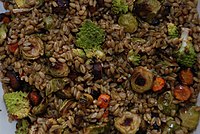Loading AI tools
Cereal food made from green durum wheat From Wikipedia, the free encyclopedia
Freekeh (sometimes spelled frikeh) or farik (Arabic: فريكة / ALA-LC: farīkah; pronounced free-kah /ˈfɹiːkə/) is a cereal food made from green durum wheat (Triticum turgidum var. durum) that is roasted and rubbed to create its flavour. It is an ancient dish derived from Levantine and North African cuisines,[1][2] remaining popular in many countries of the eastern Mediterranean Basin, where durum wheat originated.[3]
 | |
| Course | Main |
|---|---|
| Place of origin | Levant |
| Main ingredients | Green durum wheat |
The wheat is harvested while the grains are green and the seeds are still soft; it is then piled and sun-dried. The piles are carefully set on fire such that only the straw and chaff burn. Under these conditions, the high moisture content of the seeds prevents them from burning. The roasted wheat is then threshed and sun-dried to achieve a uniform flavour, texture, and colour. This threshing or rubbing process of the grains gives this food its name, farīk or "rubbed". Finally, the seeds are cracked into smaller pieces that resemble green bulgur.[1]
Freekeh is mentioned in the Hebrew Bible under the term qalûy[4] (Biblical Hebrew: קָל֤וּי, scorched or roasted) or carmel[5] (Biblical Hebrew: כַּרְמֶל), indicating it was used in ancient Israelite cuisine.[4][6][7] For instance, in the Book of Kings II, it is said that Elisha miraculously fed about a hundred people with some barley bread and carmel.[5] The Syriac version of the Bible translates the term into froka, a cognate of the Arabic freekeh.[6][7]
Freekeh is also mentioned in an early thirteenth-century Baghdad cookbook as farīkiyya.[1] In that recipe, meat is fried in oil and braised with water, salt, and cinnamon bark. Then, dried coriander is stirred in with young wheat ("freekeh") and is cooked. Finally, the meal is served with cumin, cinnamon, and fresh lamb tail fat.[1]
In his 1865 book The Land of Israel: A Journal of Travels in Palestine, British clergyman and scholar Henry Baker Tristram documented the preparation of freekeh near the Sea of Galilee:
Many fires were lighted on the shingle by the shores of the lake … A few sheaves of wheat had been brought down from the fields above; these were tossed on the fire, and as soon as the straw was consumed, the charred heads were dexterously swept from the embers onto a cloak spread on the ground. The women of the party then beat the ears and tossed them into the air until they were thoroughly winnowed, when the wheat was eaten without further preparation ... the green ears had become half-charred by the roasting, and there was a pleasant mingling of milky wheat and a fresh crust flavour, as we chewed the parched corn. We were delighted to have seen the preparation, and to have partaken parched corn, so often mentioned in the Old Testament Scriptures.[8]

In Egypt, freekeh is served as ḥamām bi’l-ferīk (pigeon stuffed with green wheat). Freekeh is also prepared in Egypt with onion and tomato, and sometimes with chicken. Shūrbat farīk bi’l-mukh is a freekeh and bone marrow soup from Tunisia. Freeket lahma, a green wheat pilaf dish with roasted lamb, spring peas, and pine nuts, comes from Jordan, and shūrba al-farīk is a soup with green wheat and chicken.[1]
In Syria, freekeh usually is prepared with lamb, onion, butter, almonds, black pepper, cinnamon, cumin, and salt.[9][10]
In Tunisia and Algeria, freekeh is usually prepared as a main ingredient in a tomato-based soup called Chorba frik and is considered a traditional food.[11][12]
In Turkey, freekeh is known as firik, and a pilaf dish based on freekeh, called firik pilavı, is found in traditional Southern Anatolian cuisine. It may be combined with bulgur; legumes such as chickpeas and various herbs and spices, and sometimes meat, may be added. With the influx of millions of Syrian refugees since 2011, firik is available in markets all over Turkey.[13]
In Palestine (region), a variety of freekeh pilaf is made with lamb, onion, olive oil, raisins, dried cherry plums, almonds, pine nuts, black pepper, cinnamon, cumin, and salt. Freekeh is also served in a soup along with chickpeas and meat (beef or chicken).[14][15]
| Nutritional value per 100 g (3.5 oz) | |||||||||||||||||||||||||||||||||||||||||
|---|---|---|---|---|---|---|---|---|---|---|---|---|---|---|---|---|---|---|---|---|---|---|---|---|---|---|---|---|---|---|---|---|---|---|---|---|---|---|---|---|---|
| Energy | 1,418 kJ (339 kcal) | ||||||||||||||||||||||||||||||||||||||||
71 g | |||||||||||||||||||||||||||||||||||||||||
2.5 g | |||||||||||||||||||||||||||||||||||||||||
14 g | |||||||||||||||||||||||||||||||||||||||||
| |||||||||||||||||||||||||||||||||||||||||
| Other constituents | Quantity | ||||||||||||||||||||||||||||||||||||||||
| selenium | 89 ug | ||||||||||||||||||||||||||||||||||||||||
| water | 11 g | ||||||||||||||||||||||||||||||||||||||||
| †Percentages estimated using US recommendations for adults,[16] except for potassium, which is estimated based on expert recommendation from the National Academies.[17] | |||||||||||||||||||||||||||||||||||||||||
Freekeh is comparable in nutritional content to other cereal grains, especially durum wheat, from which it is derived, depending on the durum cultivar.[1][18] Durum is notable for its high content of protein (20% or more of the Daily Value, DV), dietary fiber, B vitamins, and several dietary minerals, especially manganese (143% DV) (table). Before roasting, freekeh is 11% water, 71% carbohydrates, 2.5% fat, and 14% protein.
Seamless Wikipedia browsing. On steroids.
Every time you click a link to Wikipedia, Wiktionary or Wikiquote in your browser's search results, it will show the modern Wikiwand interface.
Wikiwand extension is a five stars, simple, with minimum permission required to keep your browsing private, safe and transparent.